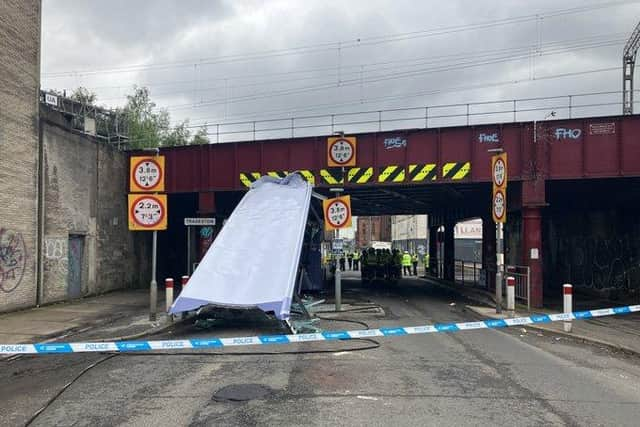Exclusive:Glasgow Central rail bridge hit by bus had been struck 16 times in last decade
A rail bridge near Scotland’s busiest station which was struck by bus in which 19 people were injured has been hit by vehicles 16 previous times over the last decade, The Scotsman has learned.
The roof of the double decker was sheared off in the incident on May 21 in Cook Street, just south of Glasgow Central.
Advertisement
Hide AdAdvertisement
Hide AdThe crash caused major disruption to rail and road networks while the bridge was closed for safety inspections, which is likely to have been even greater had it not happened on a Sunday when fewer trains run.
Network Rail said 56 trains were cancelled for all or part of their routes, while there were also delays to other services which totalled four-and-a-half hours. Routes affected included the Paisley, Ayr, Largs and Gourock lines.
Police Scotland said a 48-year-old man was charged with a road traffic offence in relation to the incident.
Network Rail, which is responsible for rail infrastructure, has revealed in a response to a freedom of information request that the bridge in the Tradeston area has suffered multiple vehicle strikes over the last ten years.


A breakdown provided to The Scotsman showed the previous incidents included three last year involving lorries, which was the most for nine years after eight collisions in 2013. There were a further two strikes in 2014 and one each in 2015, 2017 and 2018. The Network Rail figures also showed a bridge in adjacent Wallace Street was struck seven times over the same period.
All the incidents where the vehicle type was recorded involved lorries apart the one in May, and another bus hitting the Cook Street bridge in 2014, in which there were no injuries.
In 1994, five girls were killed when a bus hit a rail bridge in nearby West Street, which is no longer a through route.
Network Rail chairman Sir Peter Hendy has said bridge strikes caused up to 2 per cent of all rail delays. The body estimated it cost the industry £23 million a year with nearly 2,000 incidents across Britain annually – or around five a day. It described the problem as a “significant safety issue for both road and rail users”.
Advertisement
Hide AdAdvertisement
Hide AdHaulage industry sources said the problem was largely caused by drivers failing to spot warning signs or not knowing the height of their vehicle.
Neil Greig, the Scotland-based policy and research director of motoring group IAM RoadSmart, said: “Lorry drivers are clearly the biggest offenders when it comes to bridge strikes on these rail lines. It is essential that signposting is kept in tip-top condition and education and enforcement campaigns continue.
"The outcome of all investigations into the recent crash must be made public so that lessons can be learned. If individual or corporate failings are identified then strong sanctions should be applied.”
A Network Rail spokesperson said: “All of our bridges are regularly inspected and low structures carry clear signage to warn approaching motorists.
"We work hard alongside local authorities, the road haulage industry and others to reduce the risk of bridge strikes. The number of bridge strikes at the locations covered by this freedom of information request have reduced over time, with 50 per cent of the incidents predating the end of 2014.”
Comments
Want to join the conversation? Please or to comment on this article.